

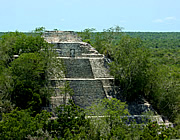
Calakmul, deep in the jungle, is the most atmospheric and memorable of all the Mayan sites we visited, by far our favourite for its remoteness, air of mystery, amazing pyramids and magnificent views over the canopy of trees.

With a long drive ahead of us we left Palenque very early in the morning while it was still dark. On our way to Campeche we were visiting the ancient site of Calakmul, a two hour detour off the Palenque-Campeche road.
We had specifically requested to add Calakmul to our itinerary because it sounded so wonderful and it became our favourite Mayan site of the many that we visited.
Today it is shrouded in jungle, though this has been cleared a little from around the major buildings. Much remains to be discovered. One of our most enduring memories is the view from the great pyramid, the tops of temples rising through the canopy of trees.
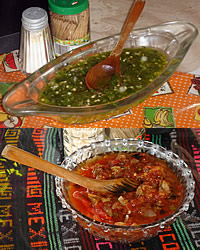

As we drove north the sun came up a huge glowing ball, suffusing the landscape with a beautiful pink light.
Our guide and driver needed a breakfast stop on the way, we just had coffee. It was a very simple place, but clean, with a corrugated iron roof and wooden shutters. The usual dishes of green and red chilli dips were on the tables with jars of flowers and a collection of branding irons along one wall.
The final forty kilometres to Calakmul is a narrow road where we could do no more than 30 km/hr. But the forest it travels through is beautiful and all the way clouds of large yellow butterflies danced in the sunlight - another beautiful memory. We also saw about half a dozen huge iridescent blue butterflies.
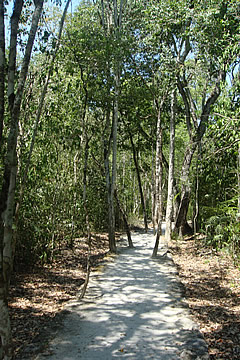
In among the trees were some very large birds, I think ocellated turkeys.
The forest is very dense, a wall of trees on either side, and it's amazing to think that Calakmul was ever discovered - it is located in the largest tropical jungle of Mexico. It wasn't until 1931 that American botanist Cyrus L Lundell stumbled on the ruins.1 It was he who named it Calakmul: in Mayan Ca - two, lak - adjacent, mul - mound or pyramid - so it was named as the City of the Two Adjacent Pyramids.
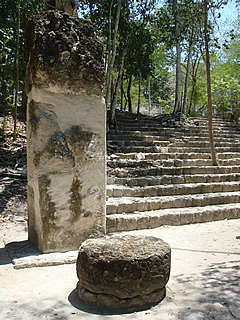
Mesoamerican civilisation is divided into pre-Classic upto about 300AD, Classic until 800-900AD and post-Classic from then up to the Spanish conquest in the sixteenth century.
It rapidly became clear to archaeologists that Calakmul was a very important city. It extended over an area of 70 sq km, encompassing ceremonial and residential areas with around seven thousand structures and a ring of reservoirs supporting a population of maybe 50,000. Calakmul has the largest number of stelae, upwards of 120, found still in place, though many are badly eroded, and many tombs, some of which are thought to be for the ruling elite. Its glyph was a snake emblem and it was known as the Snake Kingdom. The emblem is found at many other Mayan sites.
Much of the story of Calakmul is gleaned from the decipherable inscriptions on its stelae and engravings at many other, sometimes very distant, Mayan sites, such as Copan, hundreds of kilometres to the south in present-day Honduras. 2
In pre-Classic times the dominant Mayan city seems to have been El Mirador, about 50km south of Calakmul in Guatemala. It was succeeded by Tikal, rivaled by Calakmul. While there is evidence that Calakmul was founded by descendents of the Mayans of El Mirador, it seems that Tikal was under the influence of Teotihuacan, to the north of present-day Mexico City.
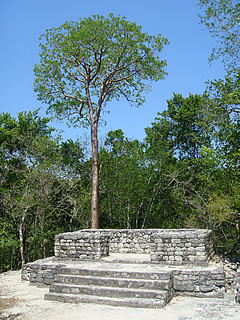
Calakmul forced Tikal into a 130 year period of decline from 562A.D., and further advanced its influence by installing vassals to rule smaller Mayan cities. Between 250 and 750 it was the centre of the Kingdom of the Serpent and during the seventh century was the dominant force in the region, defeating Palenque at least twice, until Tikal again asserted supremacy toward the end of the century.2 At its peak it controlled an area of around 13,000 sq km.
In the eighth century a Calakmul princess, Lady Ik Skull, married Shield Jaguar III of Yaxchilan in an effort to cement peace between the two warring cities. During this period Calakmul is also thought to have supported distant Quiriguá in its rebellion against Copan.
During the ninth century, like many other Mayan cities, Calakmul suffered adverse fortunes, amost certainly due to a change in the climate and probably drought. More than most it managed to prolong its fortunes by opening up new trade routes to the north and Gulf Coast.2 Still, by the sixteenth century it had been all but abandoned.
The area of Calakmul which has been most extensively explored consists of three zones covering maybe 2 sq km sitting on an artificially levelled limestone dome.2 A large acropolis in the west consists of a number of buildings on platforms set around spaces including residential buildings and a ballcourt. To the east a similar but smaller acropolis exists. Between these the central zone is formed by an open space surrounded by buildings, including the largest building on the site, the pyramid designated Structure II. The second largest pyramid, Structure I, lies somewhat isolated to the south east.
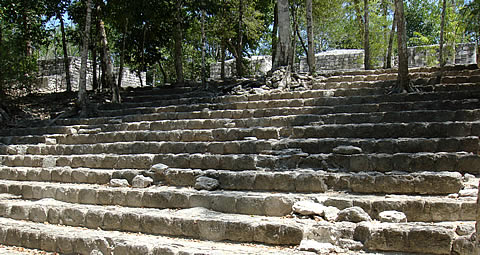
From the entrance where we parked it was quite a long walk on footpaths through the forest to the site. Young trees encroached everywhere, growing through the path. It must take an immense amount of work to keep it reasonably clear.
Though the area gets plenty of rain, and there is a nearby swamp, there are few, if any, rivers or natural lakes. For this reason the Maya built a number of reservoirs around the city and a canal system.
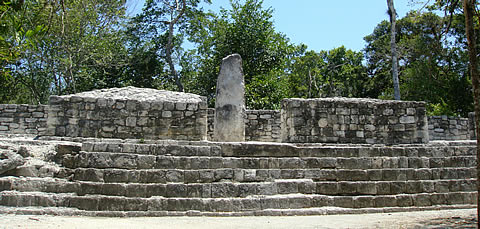
We passed the small north east group of temples. This comprises a set of steps at one side of a plaza with two stelae and a drum altar at their base, rising to a platform with three temples. Two small temples face each other across the long east-west axis of the platform with a third long rectangular temple up further steps on the northern side. The group has been well restored but there are trees growing on the steps which can only be causing damage.
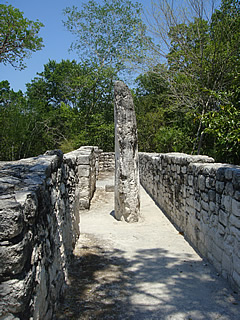
The south-facing temple has a large stela standing within its walls - so badly weathered it is impossible to see any of the original carving. This is a very long narrow space and it would be interesting to know its purpose. Perhaps it was dedicated to a past ruler, glorified on the stela which is centrally placed and visible through an entrance.
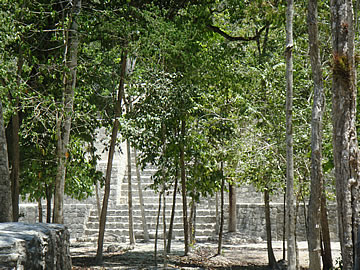
It took a further twenty minutes to get to the Central Plaza. We passed several ruins along the way, hidden in the trees and looking very mysterious.
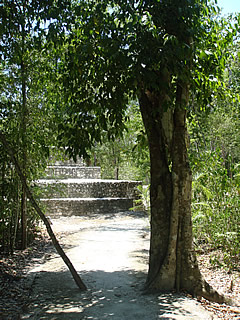
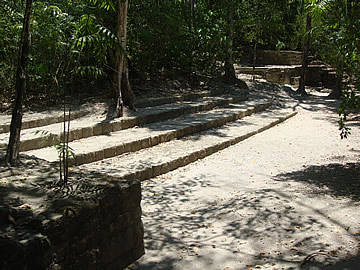
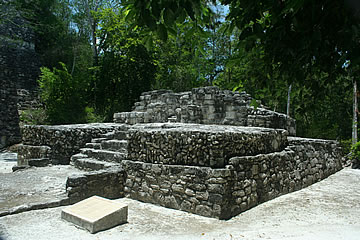
We were completely alone at Calakmul, we didn't see another tourist in all the time we were there, just us and our guide and driver. It was magical, amazing, unforgettable.
We entered the Central Plaza in the central zone of the site. It is rather overgrown, massive structures seen through the trees keep up the feeling of mystery.
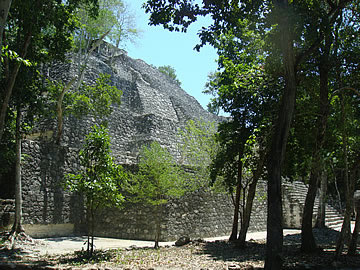
Structure VIII, looks like a small, but well-formed after-thought, squeezed at an angle on the north east corner of the plaza. It lies on the eastern side of Structure VII, a lovely 24m high pyramid which stands on the northern edge of the Central Plaza.
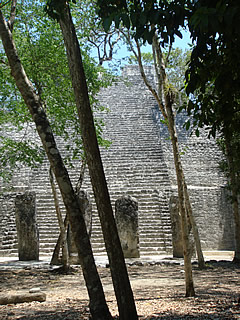
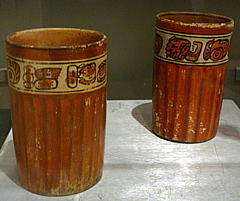
At the bottom of the steep steps leading up Structure VII are five stelae and on the platform at the top was a three-roomed temple.
Like most Mayan buildings Structure VII underwent several phases of construction: the earliest in the Late Pre-Classic period, the central superstructure from the Late Classic, and a final phase in the Terminal Classic (the period after Late Classic).2
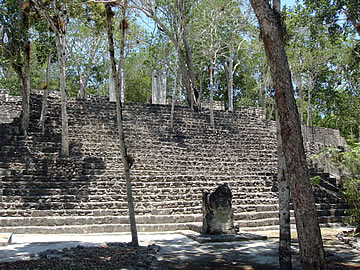
Defining the Terminal Classic At Calakumul, Campeche by Geoffrey E. Braswell et al2 paints a vivid picture of the burial of a highly-regarded male discovered in the central temple within Structure VII. The body was wrapped in a mat, whch had afterwards been exposed to fire, and buried with his jaguar cloak, jaguar claws, a portion of a tail and skull fragment It was surrounded by an enormous number of artefacts including shells, a mosaic mask, a pearl, and over 2,000 pieces of jadeite as well as obsidian blades.
On the east and west of the Central Plaza are two buildings which together form an astronomical observatory. On the west, Structure VI is a viewing platform while on the opposite side of the plaza, about 50m away, is Structure IV, a large raised platform with three temples arranged north to south.
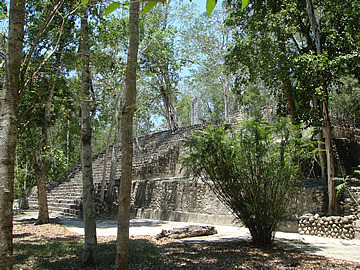
Structure VI dates originally from the Late Pre-Classic but, together with Structure IV, underwent later development into the astronomical complex .3
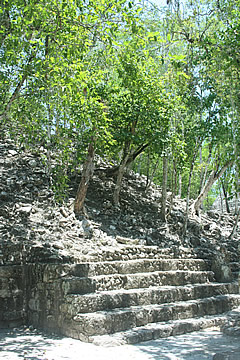
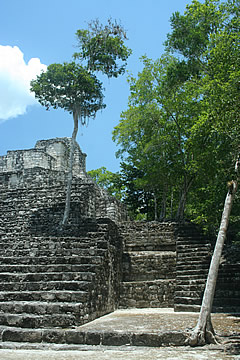
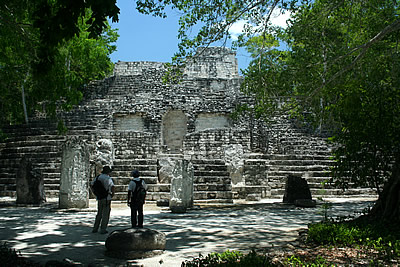
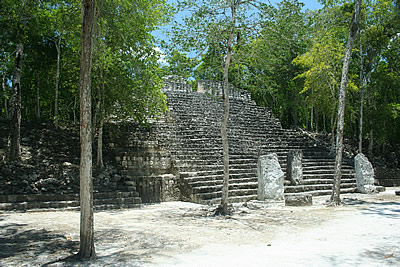
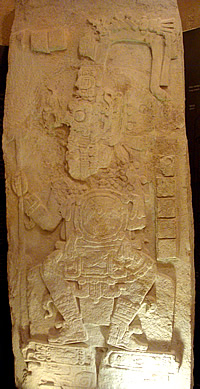
From the viewing platform of Structure VI the sun is seen to rise behind the north temple (a) at Summer Solstice, the south temple (c) at Winter Solstice, and the middle temple (b) at equinox. This type of complex is known as an E group.
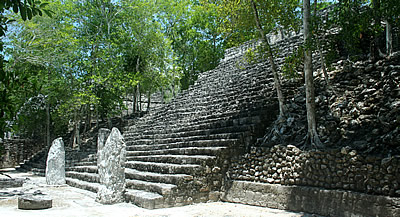
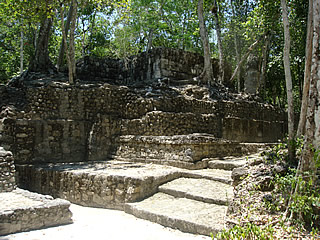
On south side of the Central Plaza is Structure V, one of the earliest buildings on the plaza. It was surrounded by paired stelae depicting a male on one and a female on the other - quite unique in the known Mayan world and almost certainly rulers and their wives.
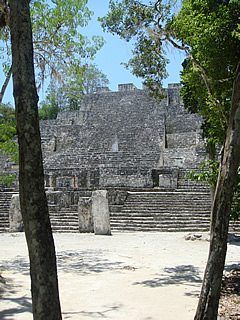
Continuing south we walked through quite a dense growth of trees. Suddenly emerging again into a bright sunlit space we were confronted by the massive bulk of Structure II - the biggest and tallest building at Calakmul.
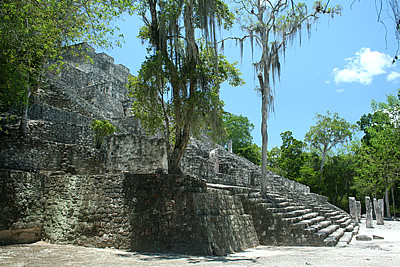
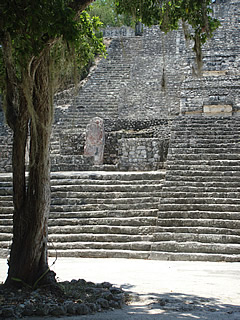
Remarkably, what we could see from ground level was only the first stage of the pyramid. At the highest point that we could see is a platform, unseen at the rear of this a pyramid temple rises high above the forest.
At 55m high and 140m on each side at ground level Structure II is one of the biggest Mayan structures ever to be built.
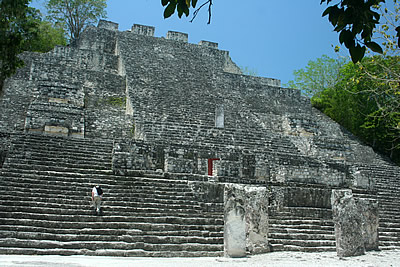
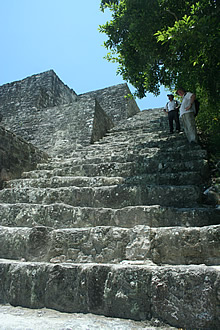
As usual it underwent several phases of construction. First built in the Late Pre-Classic there were only minor modifications through the Early Classic, such as the addition of masks. In the middle of the eighth century, however, at the height of Calakmul's power, a second phase of building substantially altered its appearance.2 The imposing central staircase was added to the north facade and three buildings - IIC IIB, and IID east to west - to the platform on its northern edge. They served as a palace complex, and as Braswell et al2 observe, altered the function of the original building from temple to a mix of sacred and secular. A male burial was discovered in IIB, dating from the Terminal Classic period it may have been the ruler of the time.
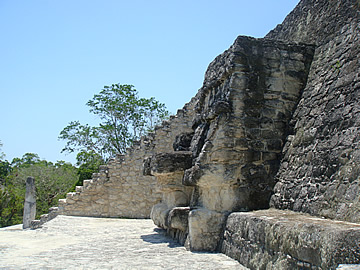
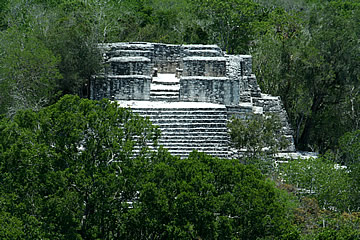
In the Late Classic and Terminal Postclassic period small crude buildings were added to the front facade. Tools, ceramics. cooking vessels and waste from craft activities suggest that these were used both as living quarters and workshops. Structure IIA, the large structure at the rear of the platform, maintained its original purpose as a temple and IIB-D continued as homes for an elite.
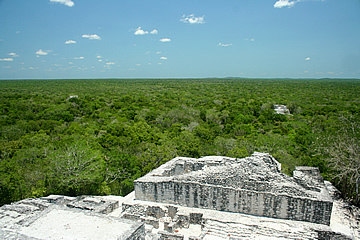
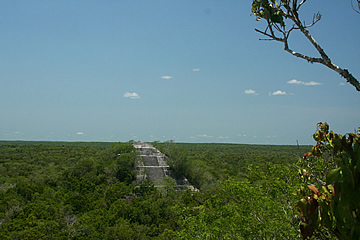
Calakmul is surrounded by dense forest. After a searingly hot climb we could see this for ourselves from the top of Structure II. As far as the eye can see, in all directions, it is green, a total canopy of trees. Nearby the tops of the highest structures of Calakmul emerge - the quintessential Mayan experience.
The most magnificent of the buildings to be seen is Structure I to the south east, rivalling Structure II in height it still seems to struggle to escape the treetops. This is because, though not quite as tall as Structure I, it is built on a rise in the ground which brings it to roughly the same height. Also because it is virtually covered in trees!
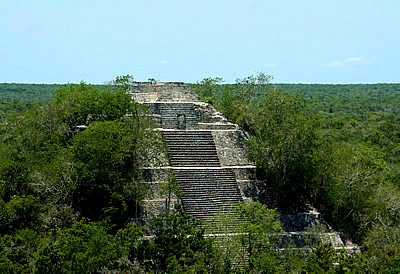
With binoculars we tried to see if we could spot El Mirador but even though it was an amazingly clear day we couldn't see anything that we could positively identify as temples poking through the canopy.

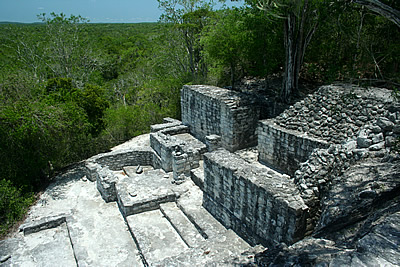
We descended the pyramid on the east side of the north face where evidence of rooms can be seen, including an unusual curving piece of wall.
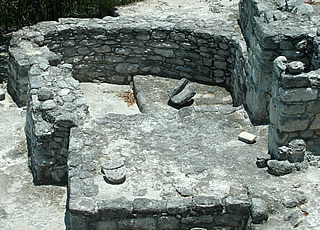
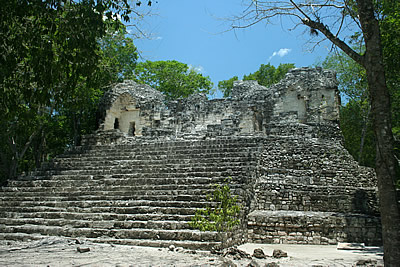
We continued our explorations, going on to Structure III. This was another very important building which stands on the western edge of the Small Acropolis on the eastern side of the site. It faces west and has been identified as a palace of the ruling elite.2 It has been little altered since it was built in the Early Classic period and continuously occupied until the Terminal Classic, throughout the times of prosperity of Calakmul.
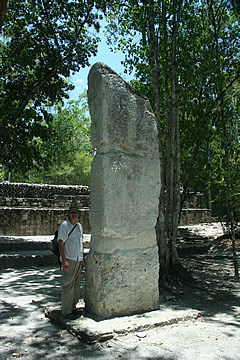
A very important burial was discovered within the palace. It is thought to have been that of a fourth or fifth century ruler. The grave goods were particularly impressive incuding three fabulous jade mosaic masks.4
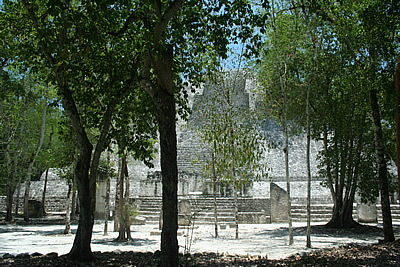
There are at least thirteen royal tombs in the buildings of the central plaza, most in Structure II. The design of tombs changed a great deal over the centuries. In the fourth to the eighth centuries funeral chambers had vaulted rooms and were intended as the final resting place of the rulers. By the ninth century, however, tombs were simply pits dug into the floor and the remains would later be removed.5
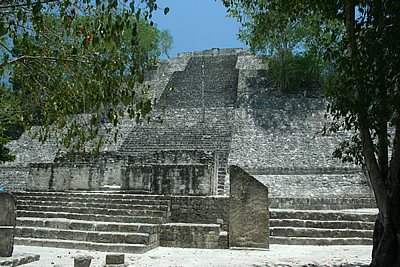
Finally we came to the immense Structure I, a classic stepped pyramid rising steeply out of the forest. At 50m high it is second only to Structure II in size, but appears to be of roughly the same height as it is built on a small hill.
We made our way back through the Central Plaza and on out of the site; having spent over two hours exploring we were hot and tired. Along the way we were accompanied by the Howler Monkeys lazing in the trees - they have too much sense to be active when the sun is so high in the sky!
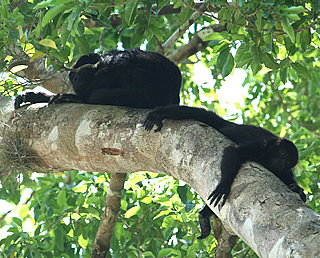
Calakmul was by far our favourite Mayan site for its remoteness, air of mystery, amazing pyramids and magnificent views over the jungle. Hopefully it will never be spoilt by mass tourism.